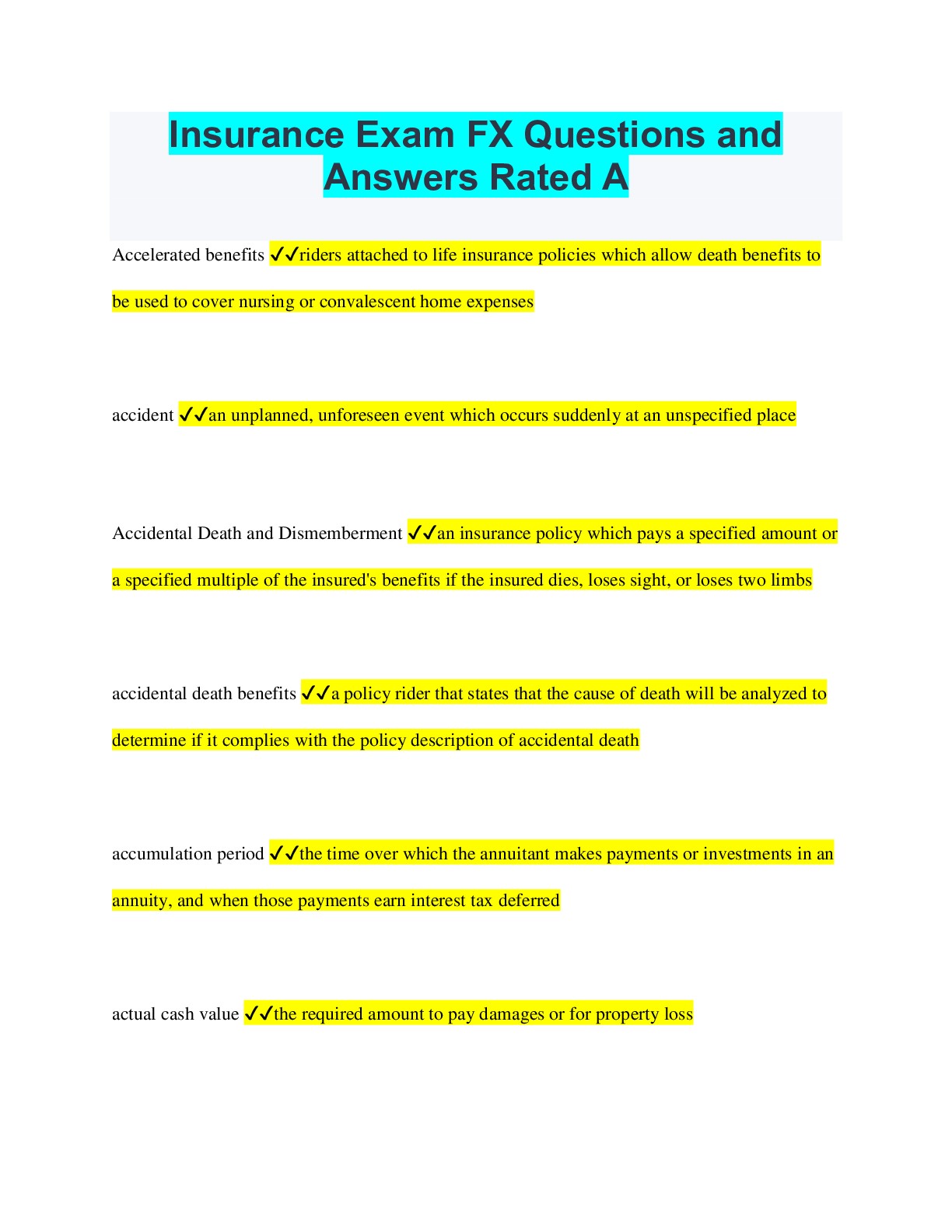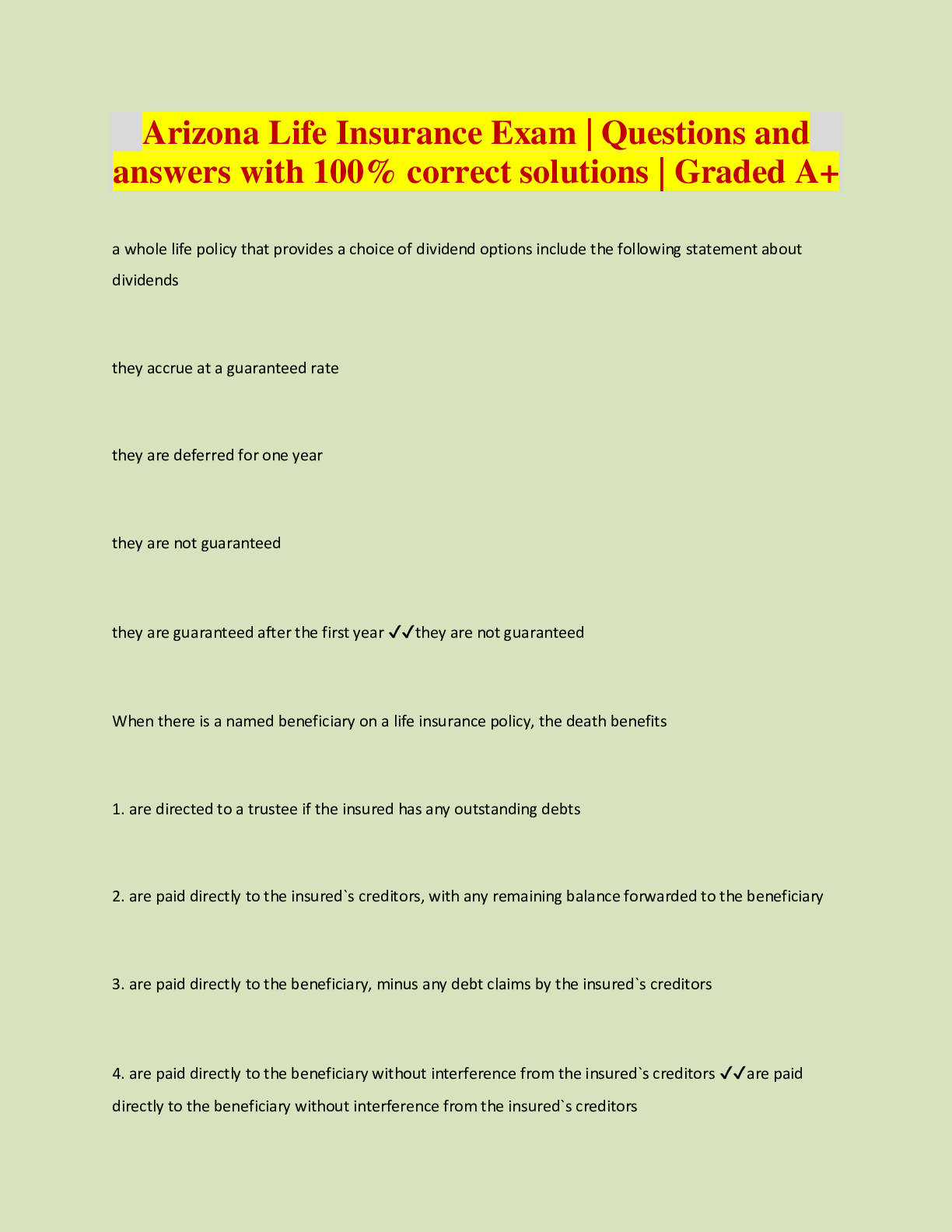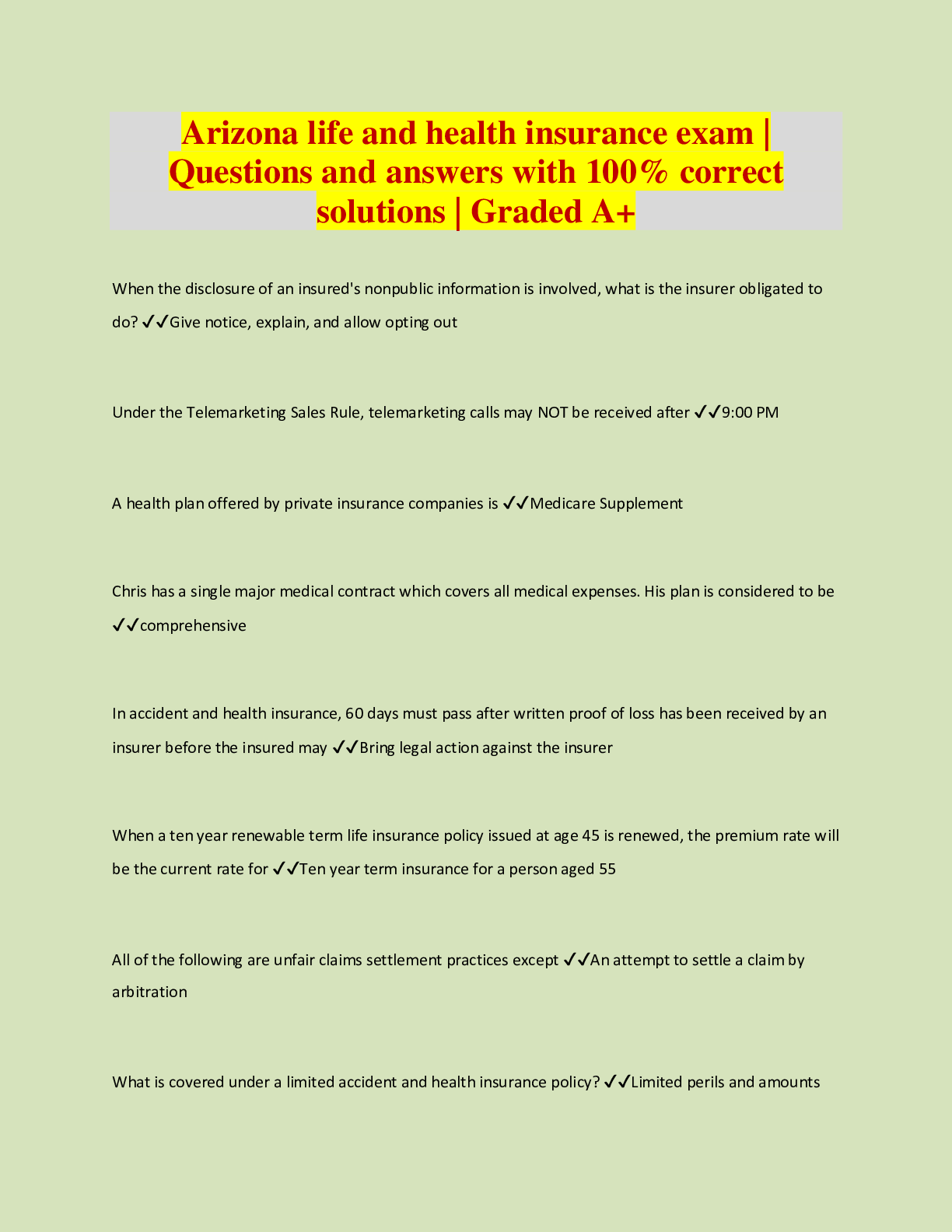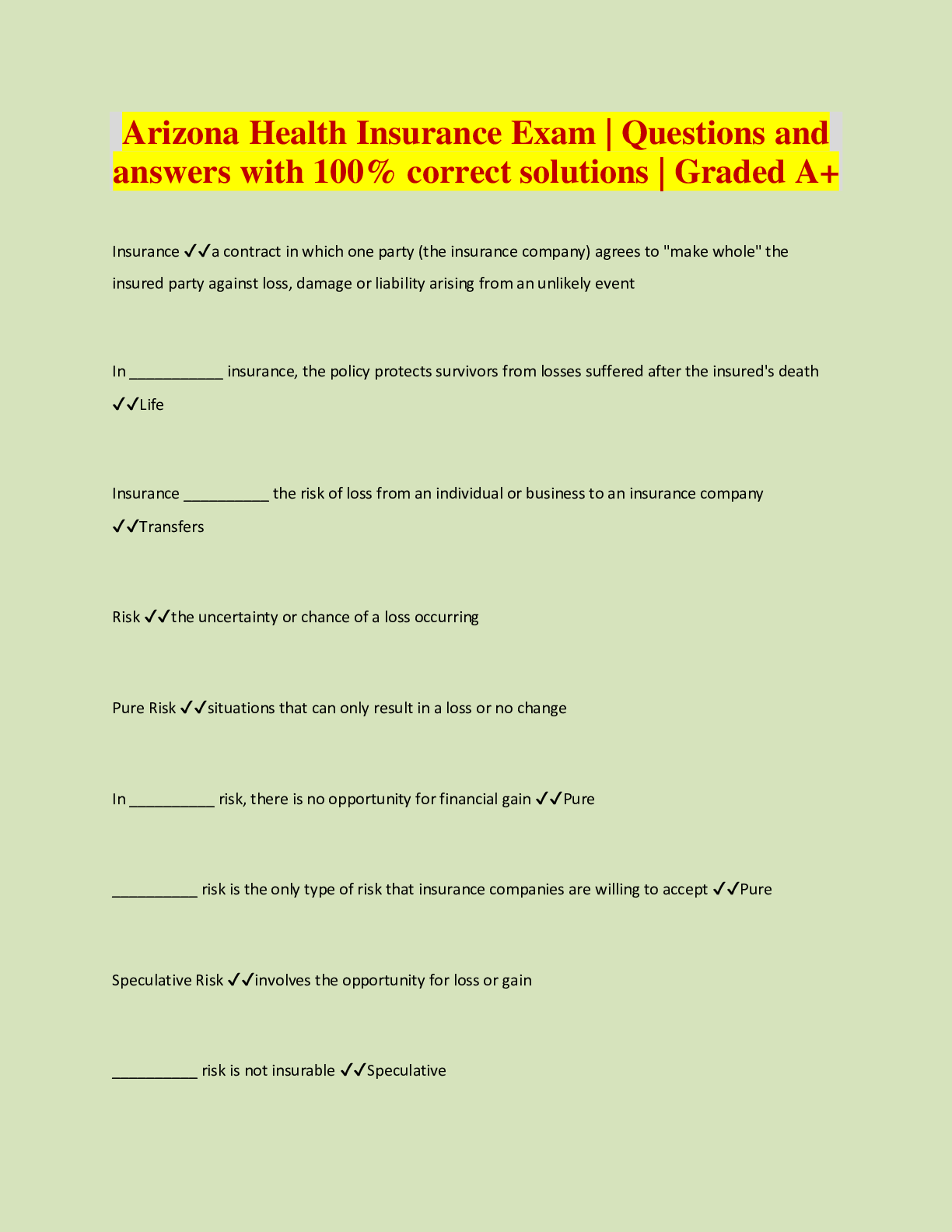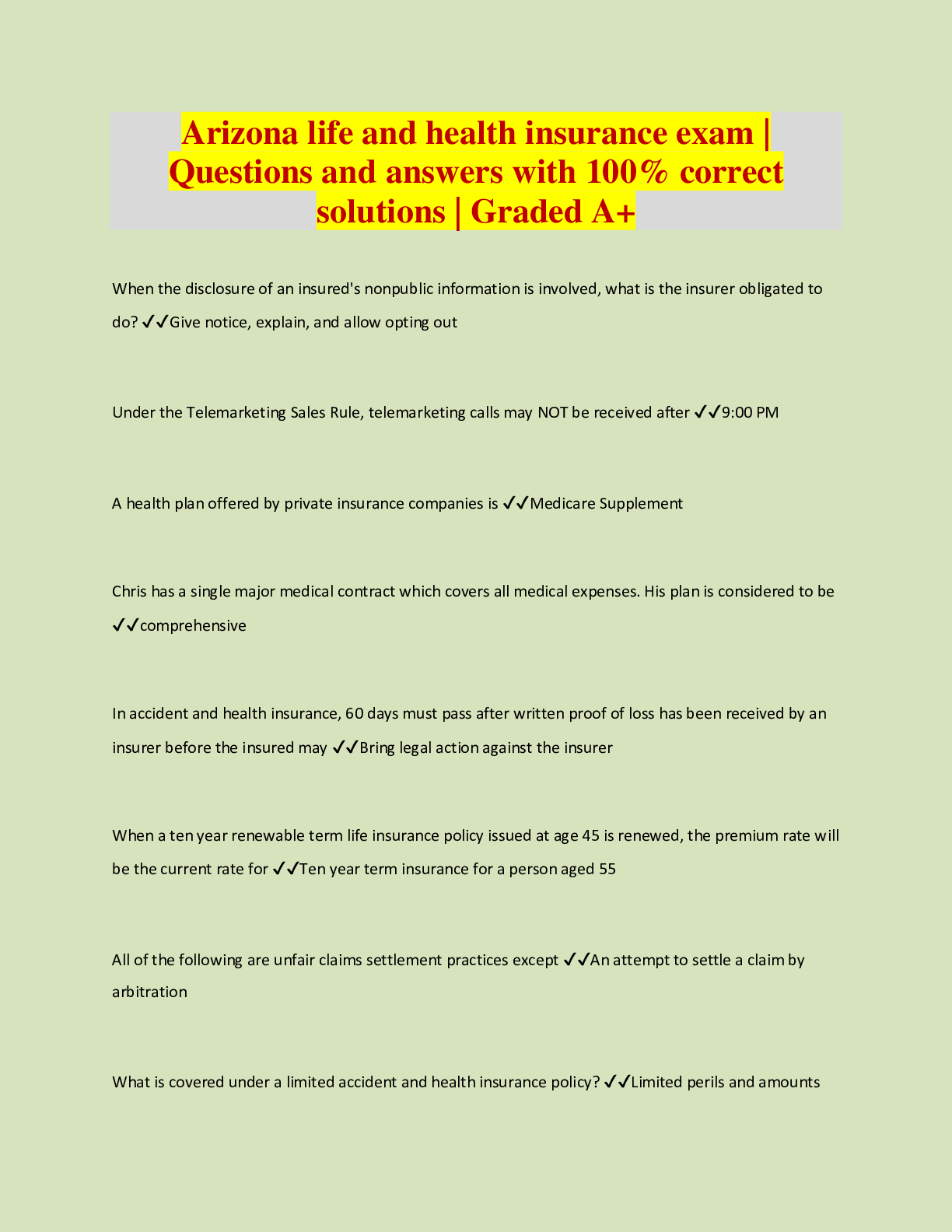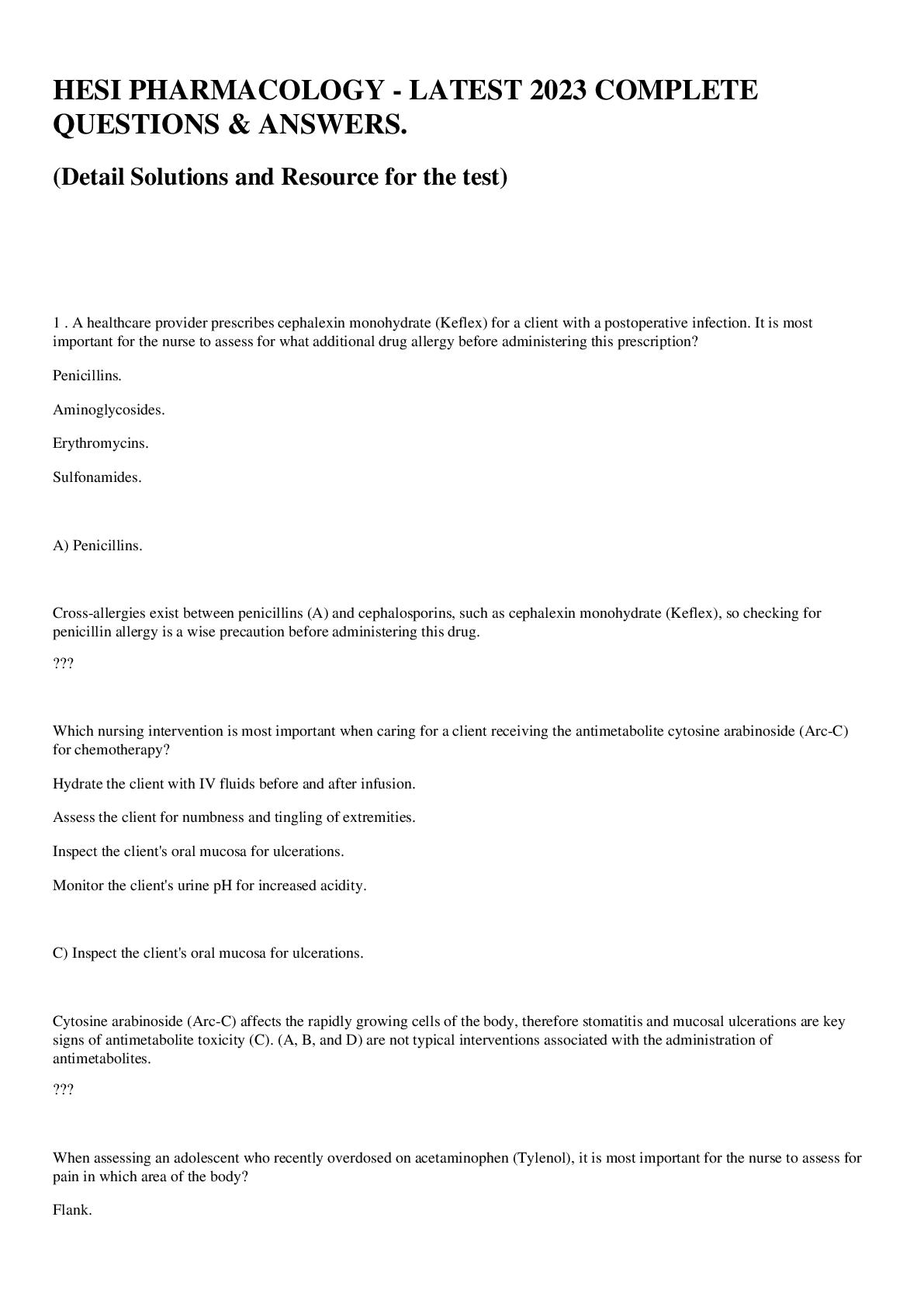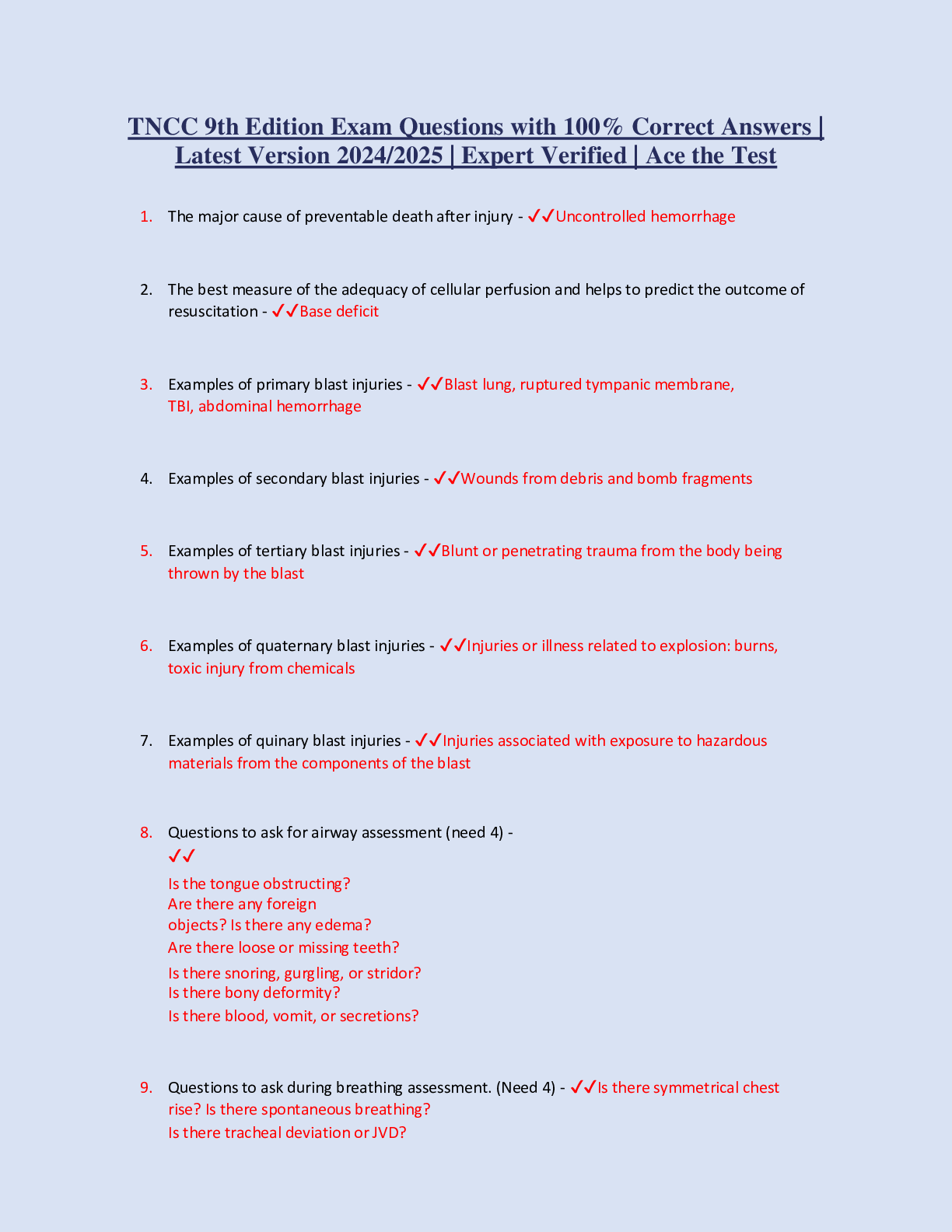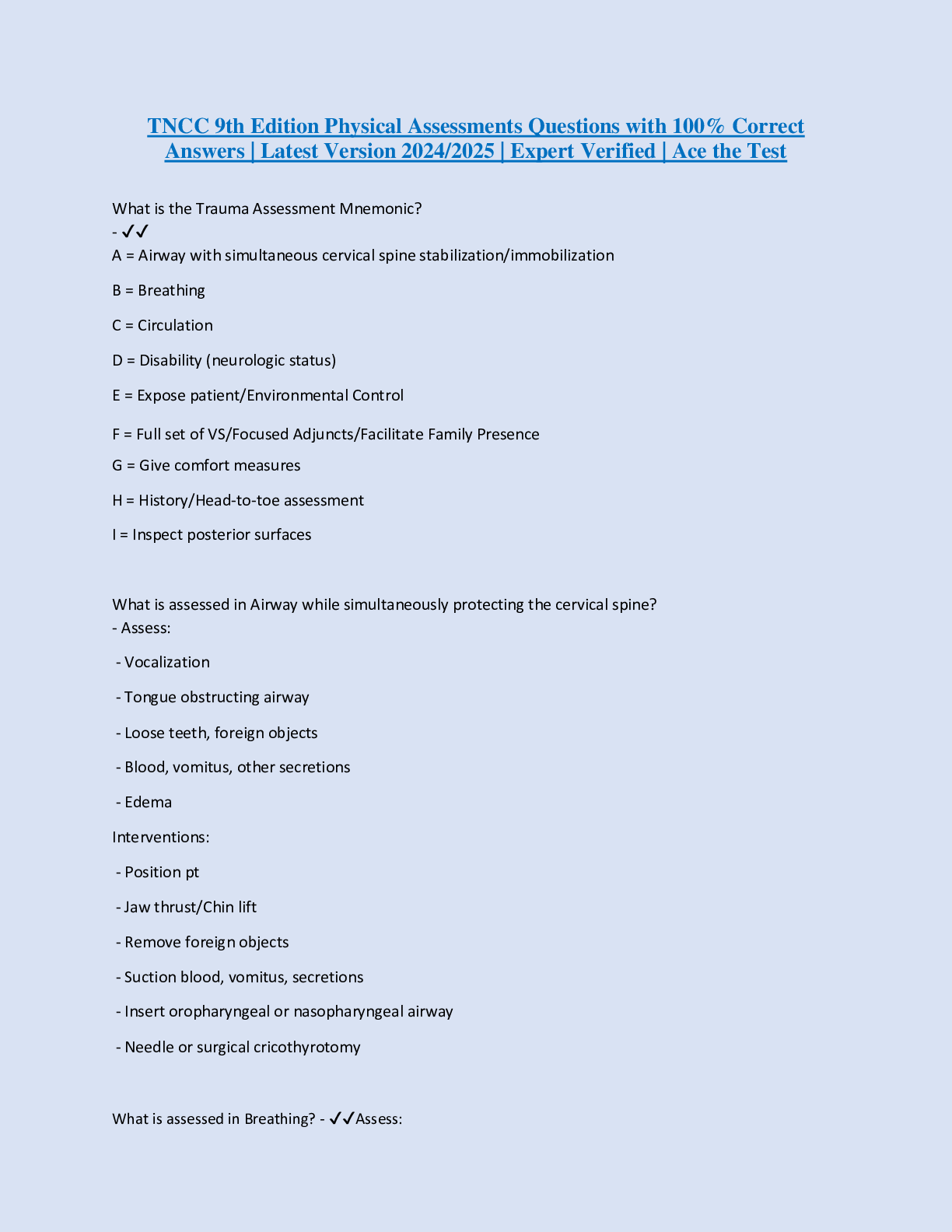Health Care > EXAM > A&P Ch. 21 Integumentary System with 100% Verified Solutions | Updated & Verified | 2024A&P Ch. 21 I (All)
A&P Ch. 21 Integumentary System with 100% Verified Solutions | Updated & Verified | 2024A&P Ch. 21 Integumentary System with 100% Verified Solutions | Updated & Verified | 2024
Document Content and Description Below
weight of skin - ✔✔6 lbs skin - ✔✔largest organ of the human body 5 main functions of the integumentary system - ✔✔protection, regulation, sensation, absorption, and secretion vitamin ... D - ✔✔produced in skin Regulation (skin) - ✔✔temperature rises in body temperature - blood vessel dilate. Sensation (skin) - ✔✔contains microscopic nerve endings. sensory reaction types - ✔✔pressure, traction, heat, cold, pain, etc. Absorption (skin) - ✔✔Oil, water and vitamins provide necessary moisture , nourishment and protection Secretion (skin) - ✔✔perspiration build up causes bacterial growth - creating body odor Layers of skin - ✔✔epidermis, dermis, subcutaneous Epidermis - ✔✔outermost layer of skinDermis - ✔✔middle layer of skin subcutaneous layer - ✔✔innermost layer of the skin, containing fat tissue shaft (hair) - ✔✔the portion above the skin surface (visible) pilomotor muscles - ✔✔Cause erection of hairs in response to cold, irritation, or emotional stimuli nail - ✔✔consists of the body, root, and matrix matrix (nail) - ✔✔nail bed A lost fingernail may take _________ months to regrow - ✔✔3.5 - 5.5 A lost toenail may take _________ months to regrow - ✔✔6 - 8 sebaceous glands - ✔✔oil glands in the skin sebum - ✔✔the oily secretion of the sebaceous glands sudoriferous glands - ✔✔sweat glands benign - ✔✔noncancerous malignant - ✔✔cancerous more prone to skin cancer - ✔✔natural redheads and blondes, people with fairer skin3 major types of skin cancer - ✔✔1. Basal cell carcinoma 2. Squamous cell carcinoma 3. Malignant Melanoma basal cell carcinoma - ✔✔most common type of skin cancer. often presents on the nose Mohs micrographic surgery - ✔✔Microscopic shaving of small tumors (Chemosurgery). cure rates of 90% in basal cell carcinoma. squamous cell carcinoma - ✔✔Type of skin cancer more serious than basal cell carcinoma; often characterized by scaly red papules or nodules. chemotherapy - ✔✔last resort to treatment of squamous cell carcinoma if surgery and radiation fail malignant melanoma - ✔✔malignant tumor composed of melanocytes the child (life span) - ✔✔skin conditions can be acute or chronic, may present as systemic infections the older adult (life span) - ✔✔skin becomes looser, by 50 half of all adults have some gray hair acne vulgaris - ✔✔common skin condition that occurs when oil and dead skin cells clog the skin's pores. most common in teens (~85% of all teens) severe acne - ✔✔can lead to emotional and physical scars. cystic lesions - ✔✔pimples that are large and deep alopecia - ✔✔hair lossalopecia areata - ✔✔Patchy loss of hair occurring on the scalp or other parts of the body. occurs in about 1 in 100 people (mostly teens and young adults) cellulitis - ✔✔acute infection of the skin and subcutaneous tissue. often caused by a cut, ulceration, or abrasion Cellulitis risk factors - ✔✔IV drug use, impairment of the immune system, and diabetes erythema - ✔✔redness of the skin Staphylococcus (staph) - ✔✔cause of cellulitis, treated with penicillin based antibiotics contact dermatitis - ✔✔irritated or allergic response of the skin coming in contact with an irritating substance vesicles - ✔✔small blisters decubitus ulcer - ✔✔Pressure sore or bed sore, it is an ulcer, initially of the skin, due to prolonged pressure. Stage 1 decubitus ulcer - ✔✔reddened area of skin Stage 2 decubitus ulcer - ✔✔Superficial blistering and breakdown of skin layers Stage 3 decubitus ulcer - ✔✔Full Thickness to subcutaneous; muscle exposed Stage 4 Decubitus Ulcer - ✔✔damage to bone and/or muscle eczema (atopic dermatitis) - ✔✔inflammation of the skin with lesions caused by allergy.treated with corticosteroids and "TIMs" furuncle - ✔✔a boil carbuncle - ✔✔a cluster of connected furuncles (boils) Folliculitis - ✔✔an infection or inflammation of the hair follicles. Commonly in the face, scalp, armpits, and legs herpes simplex - ✔✔Recurring viral infection that often presents as a fever blister or cold sore with potentially a fever. herpes simplex virus type 1 - ✔✔the form of herpes that generates cold sores or fever blisters around the mouth herpes simplex virus type 2 - ✔✔sexually transmitted, ulcer-like lesions of the genitals herpes zoster - ✔✔shingles, viral infection affecting peripheral nerves that causes a painful rash hirsutism - ✔✔excessive hair growth Impetigo - ✔✔bacterial skin infection characterized by isolated pustules that become crusted and rupture. Common in children and very contagious tinea - ✔✔infection of the skin caused by a fungus tinea corporis - ✔✔ringworm tinea capitis - ✔✔fungal infection of the scalptinea pedis - ✔✔athlete's foot tinea cruris - ✔✔jock itch Uticaria - ✔✔hives. Hypersensitivity to medications, foods, or environmental stimuli vitiligo - ✔✔leukoderma. white patches on the skin caused by the destruction of melanocytes associated with autoimmune disorders (such as Addison's disease or pernicious anemia) Vitiligo treatment - ✔✔evening skin tone and color Verrucae (warts) - ✔✔HPV family (more than 60 types) botox - ✔✔neurotoxin injected into muscles of the face to prevent the muscles from contracting and causing wrinkles Botox side effects - ✔✔dry mouth discomfort/pain at injection site tiredness headache neck pain eye drooping light chemical peel - ✔✔The purpose of this peel is to reduce the size of pores, make the skin appear softer, and produce more coloring in the skinmedium chemical peel - ✔✔The purpose of this peel is to reduce wrinkles, make the skin appear softer than light chemical peels Deep chemical peel - ✔✔aggressive treatment that can affect the layers of skin down to the dermal layer. May remove precancerous lesions Laser resurfacing - ✔✔Uses a beam of highly focused light to vaporize the upper layers of damaged skin at specific and controlled levels of penetration. may take 1-2 hours Microdermabrasion - ✔✔Mechanical exfoliation that is noninvasive and non-chemicalweight of skin - ✔✔6 lbs skin - ✔✔largest organ of the human body 5 main functions of the integumentary system - ✔✔protection, regulation, sensation, absorption, and secretion vitamin D - ✔✔produced in skin Regulation (skin) - ✔✔temperature rises in body temperature - blood vessel dilate. Sensation (skin) - ✔✔contains microscopic nerve endings. sensory reaction types - ✔✔pressure, traction, heat, cold, pain, etc. Absorption (skin) - ✔✔Oil, water and vitamins provide necessary moisture , nourishment and protection Secretion (skin) - ✔✔perspiration build up causes bacterial growth - creating body odor Layers of skin - ✔✔epidermis, dermis, subcutaneous Epidermis - ✔✔outermost layer of skinDermis - ✔✔middle layer of skin subcutaneous layer - ✔✔innermost layer of the skin, containing fat tissue shaft (hair) - ✔✔the portion above the skin surface (visible) pilomotor muscles - ✔✔Cause erection of hairs in response to cold, irritation, or emotional stimuli nail - ✔✔consists of the body, root, and matrix matrix (nail) - ✔✔nail bed A lost fingernail may take _________ months to regrow - ✔✔3.5 - 5.5 A lost toenail may take _________ months to regrow - ✔✔6 - 8 sebaceous glands - ✔✔oil glands in the skin sebum - ✔✔the oily secretion of the sebaceous glands sudoriferous glands - ✔✔sweat glands benign - ✔✔noncancerous malignant - ✔✔cancerous more prone to skin cancer - ✔✔natural redheads and blondes, people with fairer skin3 major types of skin cancer - ✔✔1. Basal cell carcinoma 2. Squamous cell carcinoma 3. Malignant Melanoma basal cell carcinoma - ✔✔most common type of skin cancer. often presents on the nose Mohs micrographic surgery - ✔✔Microscopic shaving of small tumors (Chemosurgery). cure rates of 90% in basal cell carcinoma. squamous cell carcinoma - ✔✔Type of skin cancer more serious than basal cell carcinoma; often characterized by scaly red papules or nodules. chemotherapy - ✔✔last resort to treatment of squamous cell carcinoma if surgery and radiation fail malignant melanoma - ✔✔malignant tumor composed of melanocytes the child (life span) - ✔✔skin conditions can be acute or chronic, may present as systemic infections the older adult (life span) - ✔✔skin becomes looser, by 50 half of all adults have some gray hair acne vulgaris - ✔✔common skin condition that occurs when oil and dead skin cells clog the skin's pores. most common in teens (~85% of all teens) severe acne - ✔✔can lead to emotional and physical scars. cystic lesions - ✔✔pimples that are large and deep alopecia - ✔✔hair lossalopecia areata - ✔✔Patchy loss of hair occurring on the scalp or other parts of the body. occurs in about 1 in 100 people (mostly teens and young adults) cellulitis - ✔✔acute infection of the skin and subcutaneous tissue. often caused by a cut, ulceration, or abrasion Cellulitis risk factors - ✔✔IV drug use, impairment of the immune system, and diabetes erythema - ✔✔redness of the skin Staphylococcus (staph) - ✔✔cause of cellulitis, treated with penicillin based antibiotics contact dermatitis - ✔✔irritated or allergic response of the skin coming in contact with an irritating substance vesicles - ✔✔small blisters decubitus ulcer - ✔✔Pressure sore or bed sore, it is an ulcer, initially of the skin, due to prolonged pressure. Stage 1 decubitus ulcer - ✔✔reddened area of skin Stage 2 decubitus ulcer - ✔✔Superficial blistering and breakdown of skin layers Stage 3 decubitus ulcer - ✔✔Full Thickness to subcutaneous; muscle exposed Stage 4 Decubitus Ulcer - ✔✔damage to bone and/or muscle eczema (atopic dermatitis) - ✔✔inflammation of the skin with lesions caused by allergy.treated with corticosteroids and "TIMs" furuncle - ✔✔a boil carbuncle - ✔✔a cluster of connected furuncles (boils) Folliculitis - ✔✔an infection or inflammation of the hair follicles. Commonly in the face, scalp, armpits, and legs herpes simplex - ✔✔Recurring viral infection that often presents as a fever blister or cold sore with potentially a fever. herpes simplex virus type 1 - ✔✔the form of herpes that generates cold sores or fever blisters around the mouth herpes simplex virus type 2 - ✔✔sexually transmitted, ulcer-like lesions of the genitals herpes zoster - ✔✔shingles, viral infection affecting peripheral nerves that causes a painful rash hirsutism - ✔✔excessive hair growth Impetigo - ✔✔bacterial skin infection characterized by isolated pustules that become crusted and rupture. Common in children and very contagious tinea - ✔✔infection of the skin caused by a fungus tinea corporis - ✔✔ringworm tinea capitis - ✔✔fungal infection of the scalptinea pedis - ✔✔athlete's foot tinea cruris - ✔✔jock itch Uticaria - ✔✔hives. Hypersensitivity to medications, foods, or environmental stimuli vitiligo - ✔✔leukoderma. white patches on the skin caused by the destruction of melanocytes associated with autoimmune disorders (such as Addison's disease or pernicious anemia) Vitiligo treatment - ✔✔evening skin tone and color Verrucae (warts) - ✔✔HPV family (more than 60 types) botox - ✔✔neurotoxin injected into muscles of the face to prevent the muscles from contracting and causing wrinkles Botox side effects - ✔✔dry mouth discomfort/pain at injection site tiredness headache neck pain eye drooping light chemical peel - ✔✔The purpose of this peel is to reduce the size of pores, make the skin appear softer, and produce more coloring in the skinmedium chemical peel - ✔✔The purpose of this peel is to reduce wrinkles, make the skin appear softer than light chemical peels Deep chemical peel - ✔✔aggressive treatment that can affect the layers of skin down to the dermal layer. May remove precancerous lesions Laser resurfacing - ✔✔Uses a beam of highly focused light to vaporize the upper layers of damaged skin at specific and controlled levels of penetration. may take 1-2 hours Microdermabrasion - ✔✔Mechanical exfoliation that is noninvasive and non-chemicalweight of skin - ✔✔6 lbs skin - ✔✔largest organ of the human body 5 main functions of the integumentary system - ✔✔protection, regulation, sensation, absorption, and secretion vitamin D - ✔✔produced in skin Regulation (skin) - ✔✔temperature rises in body temperature - blood vessel dilate. Sensation (skin) - ✔✔contains microscopic nerve endings. sensory reaction types - ✔✔pressure, traction, heat, cold, pain, etc. Absorption (skin) - ✔✔Oil, water and vitamins provide necessary moisture , nourishment and protection Secretion (skin) - ✔✔perspiration build up causes bacterial growth - creating body odor Layers of skin - ✔✔epidermis, dermis, subcutaneous Epidermis - ✔✔outermost layer of skinDermis - ✔✔middle layer of skin subcutaneous layer - ✔✔innermost layer of the skin, containing fat tissue shaft (hair) - ✔✔the portion above the skin surface (visible) pilomotor muscles - ✔✔Cause erection of hairs in response to cold, irritation, or emotional stimuli nail - ✔✔consists of the body, root, and matrix matrix (nail) - ✔✔nail bed A lost fingernail may take _________ months to regrow - ✔✔3.5 - 5.5 A lost toenail may take _________ months to regrow - ✔✔6 - 8 sebaceous glands - ✔✔oil glands in the skin sebum - ✔✔the oily secretion of the sebaceous glands sudoriferous glands - ✔✔sweat glands benign - ✔✔noncancerous malignant - ✔✔cancerous more prone to skin cancer - ✔✔natural redheads and blondes, people with fairer skin3 major types of skin cancer - ✔✔1. Basal cell carcinoma 2. Squamous cell carcinoma 3. Malignant Melanoma basal cell carcinoma - ✔✔most common type of skin cancer. often presents on the nose Mohs micrographic surgery - ✔✔Microscopic shaving of small tumors (Chemosurgery). cure rates of 90% in basal cell carcinoma. squamous cell carcinoma - ✔✔Type of skin cancer more serious than basal cell carcinoma; often characterized by scaly red papules or nodules. chemotherapy - ✔✔last resort to treatment of squamous cell carcinoma if surgery and radiation fail malignant melanoma - ✔✔malignant tumor composed of melanocytes the child (life span) - ✔✔skin conditions can be acute or chronic, may present as systemic infections the older adult (life span) - ✔✔skin becomes looser, by 50 half of all adults have some gray hair acne vulgaris - ✔✔common skin condition that occurs when oil and dead skin cells clog the skin's pores. most common in teens (~85% of all teens) severe acne - ✔✔can lead to emotional and physical scars. cystic lesions - ✔✔pimples that are large and deep alopecia - ✔✔hair lossalopecia areata - ✔✔Patchy loss of hair occurring on the scalp or other parts of the body. occurs in about 1 in 100 people (mostly teens and young adults) cellulitis - ✔✔acute infection of the skin and subcutaneous tissue. often caused by a cut, ulceration, or abrasion Cellulitis risk factors - ✔✔IV drug use, impairment of the immune system, and diabetes erythema - ✔✔redness of the skin Staphylococcus (staph) - ✔✔cause of cellulitis, treated with penicillin based antibiotics contact dermatitis - ✔✔irritated or allergic response of the skin coming in contact with an irritating substance vesicles - ✔✔small blisters decubitus ulcer - ✔✔Pressure sore or bed sore, it is an ulcer, initially of the skin, due to prolonged pressure. Stage 1 decubitus ulcer - ✔✔reddened area of skin Stage 2 decubitus ulcer - ✔✔Superficial blistering and breakdown of skin layers Stage 3 decubitus ulcer - ✔✔Full Thickness to subcutaneous; muscle exposed Stage 4 Decubitus Ulcer - ✔✔damage to bone and/or muscle eczema (atopic dermatitis) - ✔✔inflammation of the skin with lesions caused by allergy.treated with corticosteroids and "TIMs" furuncle - ✔✔a boil carbuncle - ✔✔a cluster of connected furuncles (boils) Folliculitis - ✔✔an infection or inflammation of the hair follicles. Commonly in the face, scalp, armpits, and legs herpes simplex - ✔✔Recurring viral infection that often presents as a fever blister or cold sore with potentially a fever. herpes simplex virus type 1 - ✔✔the form of herpes that generates cold sores or fever blisters around the mouth herpes simplex virus type 2 - ✔✔sexually transmitted, ulcer-like lesions of the genitals herpes zoster - ✔✔shingles, viral infection affecting peripheral nerves that causes a painful rash hirsutism - ✔✔excessive hair growth Impetigo - ✔✔bacterial skin infection characterized by isolated pustules that become crusted and rupture. Common in children and very contagious tinea - ✔✔infection of the skin caused by a fungus tinea corporis - ✔✔ringworm tinea capitis - ✔✔fungal infection of the scalptinea pedis - ✔✔athlete's foot tinea cruris - ✔✔jock itch Uticaria - ✔✔hives. Hypersensitivity to medications, foods, or environmental stimuli vitiligo - ✔✔leukoderma. white patches on the skin caused by the destruction of melanocytes associated with autoimmune disorders (such as Addison's disease or pernicious anemia) Vitiligo treatment - ✔✔evening skin tone and color Verrucae (warts) - ✔✔HPV family (more than 60 types) botox - ✔✔neurotoxin injected into muscles of the face to prevent the muscles from contracting and causing wrinkles Botox side effects - ✔✔dry mouth discomfort/pain at injection site tiredness headache neck pain eye drooping light chemical peel - ✔✔The purpose of this peel is to reduce the size of pores, make the skin appear softer, and produce more coloring in the skinmedium chemical peel - ✔✔The purpose of this peel is to reduce wrinkles, make the skin appear softer than light chemical peels Deep chemical peel - ✔✔aggressive treatment that can affect the layers of skin down to the dermal layer. May remove precancerous lesions Laser resurfacing - ✔✔Uses a beam of highly focused light to vaporize the upper layers of damaged skin at specific and controlled levels of penetration. may take 1-2 hours Microdermabrasion - ✔✔Mechanical exfoliation that is noninvasive and non-chemical [Show More]
Last updated: 10 months ago
Preview 3 out of 7 pages

Loading document previews ...
Buy this document to get the full access instantly
Instant Download Access after purchase
Buy NowInstant download
We Accept:

Reviews( 0 )
$5.00
Can't find what you want? Try our AI powered Search
Document information
Connected school, study & course
About the document
Uploaded On
Sep 16, 2024
Number of pages
7
Written in
Additional information
This document has been written for:
Uploaded
Sep 16, 2024
Downloads
0
Views
24


